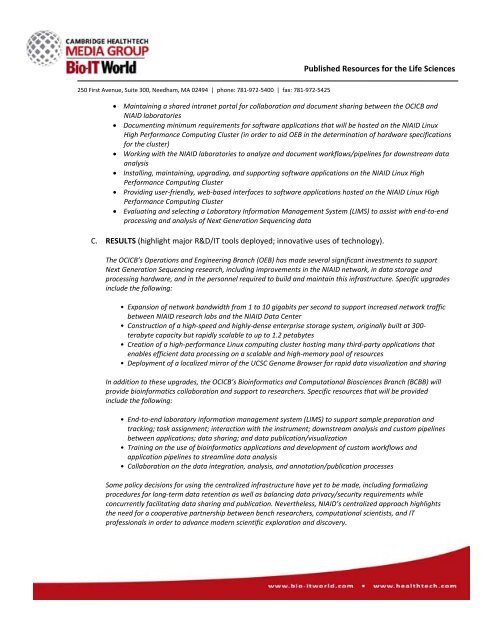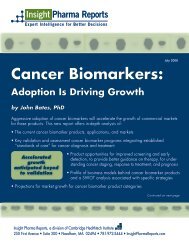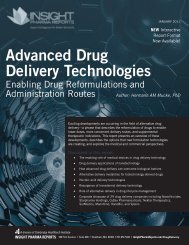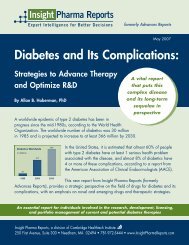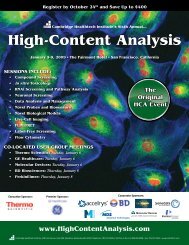2010 Best Practices Competition IT & Informatics HPC
IT Informatics - Cambridge Healthtech Institute
IT Informatics - Cambridge Healthtech Institute
- No tags were found...
Create successful ePaper yourself
Turn your PDF publications into a flip-book with our unique Google optimized e-Paper software.
Published Resources for the Life Sciences<br />
250 First Avenue, Suite 300, Needham, MA 02494 | phone: 781‐972‐5400 | fax: 781‐972‐5425<br />
• Maintaining a shared intranet portal for collaboration and document sharing between the OCICB and<br />
NIAID laboratories<br />
• Documenting minimum requirements for software applications that will be hosted on the NIAID Linux<br />
High Performance Computing Cluster (in order to aid OEB in the determination of hardware specifications<br />
for the cluster)<br />
• Working with the NIAID laboratories to analyze and document workflows/pipelines for downstream data<br />
analysis<br />
• Installing, maintaining, upgrading, and supporting software applications on the NIAID Linux High<br />
Performance Computing Cluster<br />
• Providing user‐friendly, web‐based interfaces to software applications hosted on the NIAID Linux High<br />
Performance Computing Cluster<br />
• Evaluating and selecting a Laboratory Information Management System (LIMS) to assist with end‐to‐end<br />
processing and analysis of Next Generation Sequencing data<br />
C. RESULTS (highlight major R&D/<strong>IT</strong> tools deployed; innovative uses of technology).<br />
The OCICB’s Operations and Engineering Branch (OEB) has made several significant investments to support<br />
Next Generation Sequencing research, including improvements in the NIAID network, in data storage and<br />
processing hardware, and in the personnel required to build and maintain this infrastructure. Specific upgrades<br />
include the following:<br />
• Expansion of network bandwidth from 1 to 10 gigabits per second to support increased network traffic<br />
between NIAID research labs and the NIAID Data Center<br />
• Construction of a high‐speed and highly‐dense enterprise storage system, originally built at 300‐<br />
terabyte capacity but rapidly scalable to up to 1.2 petabytes<br />
• Creation of a high‐performance Linux computing cluster hosting many third‐party applications that<br />
enables efficient data processing on a scalable and high‐memory pool of resources<br />
• Deployment of a localized mirror of the UCSC Genome Browser for rapid data visualization and sharing<br />
In addition to these upgrades, the OCICB’s Bioinformatics and Computational Biosciences Branch (BCBB) will<br />
provide bioinformatics collaboration and support to researchers. Specific resources that will be provided<br />
include the following:<br />
• End‐to‐end laboratory information management system (LIMS) to support sample preparation and<br />
tracking; task assignment; interaction with the instrument; downstream analysis and custom pipelines<br />
between applications; data sharing; and data publication/visualization<br />
• Training on the use of bioinformatics applications and development of custom workflows and<br />
application pipelines to streamline data analysis<br />
• Collaboration on the data integration, analysis, and annotation/publication processes<br />
Some policy decisions for using the centralized infrastructure have yet to be made, including formalizing<br />
procedures for long‐term data retention as well as balancing data privacy/security requirements while<br />
concurrently facilitating data sharing and publication. Nevertheless, NIAID’s centralized approach highlights<br />
the need for a cooperative partnership between bench researchers, computational scientists, and <strong>IT</strong><br />
professionals in order to advance modern scientific exploration and discovery.


